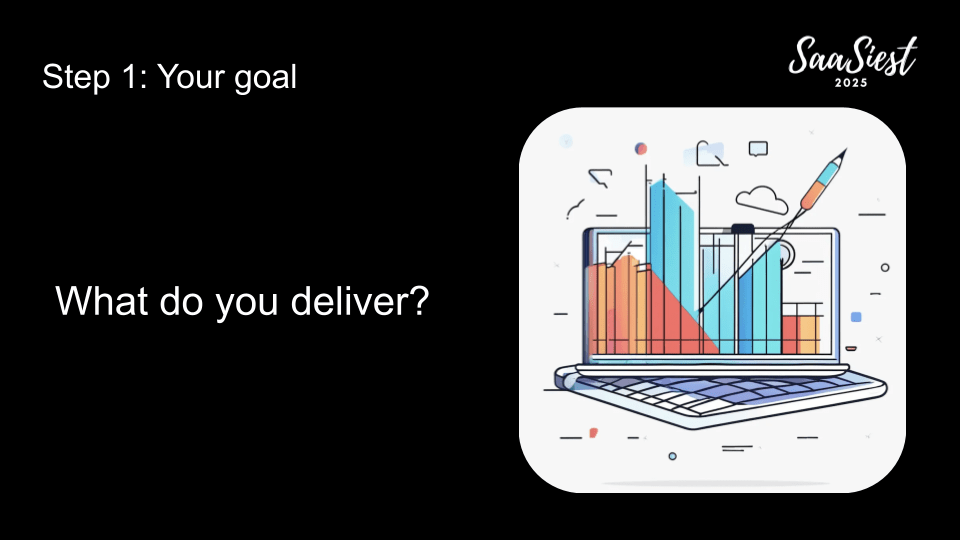Customer success leaders often find themselves shouting into the void when it comes to product collaboration. Feature requests disappear, roadmaps drift, and priorities seem misaligned. Yet in today’s SaaS world, where revenue from existing customers is more valuable than ever, those internal silos can no longer stand.
Jennifer York, Chief Customer Officer at Ometria, took the stage at SaaSiest 2025 to share a battle-tested five-step framework for CS leaders who want to become strategic drivers of net revenue retention—by speaking the language of product, finance, and growth.
Having scaled customer success at companies like HubSpot, Hootsuite, and Box before taking the reins at Ometria, Jennifer knows that long-term retention isn’t about chasing every feature request. It’s about aligning CS and product around a shared vision—and having the right conversations early enough to impact the business.
Here’s how she does it.
The Five-Step Framework for CS-Product Alignment
1. Know Your Goal—and Make It About Revenue
Before CS can influence product, it must anchor itself to the metrics that matter. That means deeply understanding whether your team is measured on gross retention, net retention, logo retention, or expansion—and how those KPIs link to overall revenue growth.
“Customer success was always revenue-focused,” Jennifer reminded the audience. “It’s brilliant that Europe has started following suit more aggressively in the last five years.”
If you’re not yet tied to revenue, start lobbying for it. You can’t drive strategic influence without aligning to the same numbers your CFO and CRO care about.

2. Understand the Company’s Financial Model
To get a seat at the table, you need to understand the game the business is playing.
Jennifer urged CS leaders to become best friends with their CFOs: “Take them for lunch. Ask what kind of chocolate they like. You need their insight.”
Why?
Because your CFO already has a three-year plan for how the business will grow: what percentage of revenue will come from retention, from expansion, and from net new customers. Understanding that breakdown helps you tie customer requests to the actual financial levers of the business.
At Ometria, Jennifer modelled out their three-year revenue plan and discovered that—despite a solid Year 1 outlook—the business couldn’t meet its net retention goals in Years 2 and 3 without a shift in product investment. By bringing that insight to the executive team, she was able to spark early alignment and prioritisation.
3. Speak the Language of Product and Engineering
It’s not enough to bring the customer voice to the table. You need to tailor your message to the people listening.
Start by learning what your product and engineering leaders actually care about. Your CTO is focused on platform scalability, reliability, and infrastructure. Your CPO is focused on user experience, vision, and market fit.
“It’s tempting to think they’ll understand your requests just because they’re building the product,” Jennifer said. “But you have to meet them where they are.”
That means ditching the laundry list of small feature requests and focusing on strategic asks that support your future ICP (Ideal Customer Profile)—not the “ICP of yesteryear.”
If you keep championing outdated customer needs, you’ll lose credibility. Focus on what will help the business grow in the next 24–36 months.
4. Map Customer Needs to Business Impact
Of course, not all customers fit your future ICP. But that doesn’t mean you abandon them.
Instead, tie your customer advocacy back to the CFO’s financial model. Show how churn in a non-strategic segment still threatens your retention revenue targets. Make your case with data, not sentiment.
At Ometria, Jennifer highlighted how SMB and mid-market customers (who no longer fit the go-forward ICP) still made up over 50 percent of retention revenue. To hit their goals and secure funding, they needed to invest in product features for that segment—even if it wasn’t the long-term focus.
“If we lose this group,” she explained, “we won’t hit our metrics. That impacts future investment. That impacts our ability to grow into the enterprise. Everything is connected.”
5. Don’t Speak Alone—Build a Chorus
To get product buy-in, you need more than a compelling case. You need advocates across the org.
Jennifer’s advice? Let others do the talking:
- Get your CRO on side. Sales and CS both drive revenue. If you arm your CRO with metrics and market insight, they can help champion your roadmap priorities.
- Loop in your CFO. If they understand the retention risk or expansion opportunity, they’ll fight for your asks in meetings you’re not in.
- Use the right forums. Join or create a Product Leadership Team. Ensure customer voices are included in roadmap planning, not just feature triage.
- Play the long game. Strategic influence takes time. You won’t win every request. But if you stay aligned with business goals and keep speaking the language of product, your impact will compound.
The New CS Playbook: Revenue, Strategy, Influence
Jennifer closed her session with a mindset shift for CS leaders: stop thinking like customer managers. Start thinking like revenue leaders.
“Don’t shy away from the same metrics sales uses,” she said. “Have a funnel. Forecast revenue. Tie your asks to customer value.”
When CS teams adopt this mindset, they stop being the department of churn and become the engine of growth.
Watch Jennifer’s session at SaaSiest 2025 here